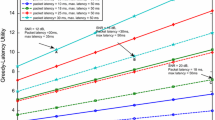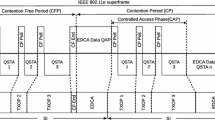Abstract
A rate-variance-envelop-based admission control (RVAC) has previously been proposed for IEEE 802.11e wireless networks. By leveraging the multiplexing gain of variable bit rate traffic, RVAC enjoys high network utilization. However, it may suffer from capacity loss due to large polling overheads, and its conservative approach to ensure the quality of service. To overcome these issues, we propose a per-flow polling scheme and derive the capacity by utilizing a stochastic ON–OFF model together with a D/G/1 model. The advantages of our method over RVAC are demonstrated through both analytical and simulation results in respect to the system capacity.







Similar content being viewed by others
Notes
Like RVAC [16], we consider only the aggregate of traffic for mathematical tractability. It should be noted that by traffic aggregation, service differentiation can no longer be possible.
Obviously, \(K\) has an upper bound, which makes \(T_f/K\) equal to the duration of a single bit.
References
IEEE Std 802.11e-2005. (2005). IEEE standard for information technology—Telecommunications and information exchange between systems—Local and metropolitan area networks—Specific requirements part 11: Wireless LAN medium access control (MAC) and physical layer (PHY) specifications amendment 8: Medium access control (MAC) quality of service enhancements.
Leonovich, A., & Ferng, H.-W. (2013). Modeling the IEEE 802.11e HCCA mode. Wireless Networks, 19(5), 771–783.
Jansang, A., & Phonphoem, A. (2013). A simple analytical model for expected frame waiting time evaluation in IEEE 802.11e HCCA mode. Wireless Personal. Communications, 69(4), 1899–1924.
Ng, B., Tan, Y. F., & Roger, Y. (2013). Improved utilization for joint HCCA-EDCA access in IEEE 802.11e WLANs. Optimization Letters, 7(8), 1711–1724.
Lagkas, T. D., Stratogiannis, D. G., & Chatzimisios, P. (2013). Modeling and performance analysis of an alternative to IEEE 802.11e hybrid control function. Telecommunication Systems, 52(4), 1961–1976.
Piro, G., Grieco, L. A., Boggia, G., & Camarda, P. (2012). QoS in wireless LAN: A comparison between feedback-based and earliest due-date approaches. Computer Communications, 35(3), 298–308.
Skyrianoglou, D., Passas, N., & Salkintzis, A. K. (2006). ARROW: An efficient traffic scheduling algorithm for IEEE 802.11e HCCA. IEEE Transactions on Wireless Communications, 5(12), 3558–3567.
Grilo, A. et al. (2003). A scheduling algorithm for QoS support in IEEE 802.11e networks. IEEE Wireless Communications Magazine, 10(3), 36–43.
Feng, L., & Li, J. (2012). Integer-multiple-spacing-based scheduling for multimedia applications in IEEE 802.11e HCCA wireless networks. Computer Networks, 56, 3767–3782.
Ruscelli, A. L., Cecchetti, G., Alifano, A., & Lipari, G. (2012). Enhancement of QoS support of HCCA schedulers using EDCA function in IEEE 802.11e networks. Ad Hoc Networks, 10(2), 147–161.
Chen, Y.-S., Lee, Y.-W., & Park, J. H. (2011). Enhanced HCCA mechanism for multimedia traffics with QoS support in IEEE 802.11e networks. Journal of Network and Computer Applications, 34, 1566–1571.
Vergados, D. J., Vergados, D. D., & Douligeris, C. (2009). DPS: An architecture for VBR scheduling in IEEE 802.11e HCCA networks with multiple access points. Mobile Networks and Applications, 14(6), 744–759.
Chou, Z.-T., Huang, C.-Q., & Chang, J. M. (2014). QoS provisioning for wireless LANs with multi-beam access point. IEEE Transactions on Mobilie Computing, 13(9), 2113–2127.
Lee, T.-H., & Hsieh, J.-R. (2013). Low-complexity class-based scheduling algorithm for scheduled automatic power-save delivery for wireless LANs. IEEE Transactions on Mobilie Computing, 12(3), 571–580.
Chou, C.-T., Shankar, S., & Shin, K. (2005). Achieving per-stream QoS with distributed airtime allocation and admission control in IEEE 802.11e wireless LANs. IEEE Infocom, 3, 1584–1595.
Gao, D., Cai, J., & Chen, C. W. (2008). Admission control based on rate-variance envelop for VBR traffic over IEEE 802.11e HCCA WLANs. IEEE Transactions on Vehicular Technology, 57(3), 1778–1788.
Sivaraman, V., & Chiussi, F. (2000). Providing end-to-end statistical delay guarantees with earliest deadline first scheduling and per-hop traffic shaping. IEEE Infocom, 2, 631–640.
Kumaran, K., & Mandjes, M. (2001). Multiplexing regulated traffic streams: Design and performance. IEEE Infocom, 1, 527–536.
Knightly, E. W. (1998). Enforceable quality of service guarantees for bursty traffic streams. IEEE Infocom, 2, 635–642.
Gross, D., Shortle, J. F., Thompson, J. M., & Harris, C. M. (2008). Fundamentals of queueing theory (4th ed.). New York: Wiley.
Nakamura, K., & Shioda, S. (2004). Statistical multiplexing of regulated sources having deterministic subadditive envelopes. Journal of the Operations Research Society of Japan, 47(4), 359–378.
NS-2 network simulator. http://www.isi.edu/nsnam/ns/.
ITU-T recommendation G.114 (1996). One-way transmission time.
Author information
Authors and Affiliations
Corresponding author
Rights and permissions
About this article
Cite this article
Huang, JJ., Liang, YJ. & Su, CY. Capacity enhancement for a rate-variance-envelop-based admission control in IEEE 802.11e HCCA WLANs. Wireless Netw 21, 2253–2261 (2015). https://doi.org/10.1007/s11276-015-0912-5
Published:
Issue Date:
DOI: https://doi.org/10.1007/s11276-015-0912-5




